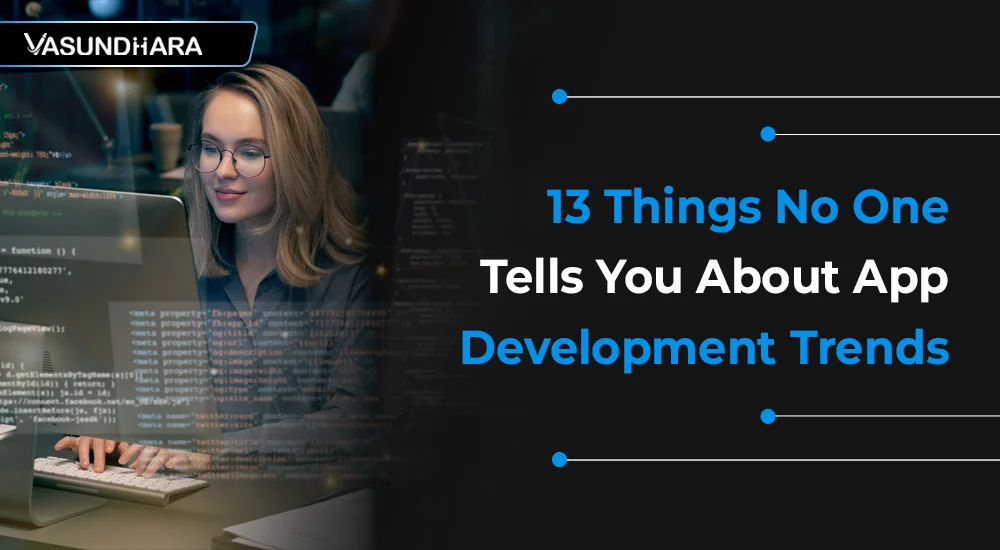13 Things No One Tells You About App Development Trends


- Apr 15, 2022



The mobile application development industry is growing rapidly as compared in comparison to other industries.
According to Bank My Cell research, 91.54% of people worldwide are using mobile phones today. And it is predicted that mobile device users will increase up to 7.516 billion by 2026.
And this projected figure will continue to rise, as technology becomes more accessible every day.
Because smartphones are the key to digital media success, companies should transform themselves accordingly, and be in the know of the top trends for better growth.
In this blog, we are going to learn about the mobile app development trends.
We live in a world where trends are a reliable source of change. The current and future business technologies will keep you up-to-date with all of it.
Learning new tools and skills is the only way to be progressive in your field. An experiment with a wider variety of components will generate new ideas. Not to forget, this will help impart better experience to users.
Users want to have flexibility and convenience with their applications. Therefore, it is imperative that you keep yourself abreast with mobile app development trends - to grow, stand out, and participate in new areas.
App development is getting faster than ever to fulfill the rising demand for new elements. Consumers expect applications with friendly, clean user interfaces.
Your brand can go far with the tech-savvy customers of today. Take a glance at the mobile app development trends that your company needs to know about:
When touchscreen phones were invented, the mobile industry saw the biggest change in user experience and its usage. Gradually, they took over the digital and business sector.
A new feature trend is that you can work on a device without touching the screen. Innovative gesture control techniques will emerge (like a tap, double-tap, press, pinch, rotate, flip, etc.) to make more intuitive and convenient mobile usage.
Peer-to-peer (P2P) payment systems are money transfer apps that are extremely safe and secure. They allow users to send capital to each other from their mobile devices.

This is one of the key trends rising in the development sector. According to Allied Market Research, the P2P market size was at $1,889.16 billion in 2020, and it was projected to reach $9,097.06 billion by 2030. It means there is huge scope in building P2P mobile apps at present.
One of the biggest ongoing trends in the market is foldable devices. And it will soon become a big-time hit in the entire smartphone industry. Developing applications integrated with these devices will be beneficial for IT firms.
This is a new era of smartphones, which is otherwise posing as the biggest challenge for developers. It is time to keep this in your mind while making a strategy for your project. This technology offers larger screens to users without changing the shape and size of the devices.
The search for app development across multiple platforms is rising exponentially. It is one of the trends that is expected to rise in the upcoming years.
Cross-platform enables a company to create and deploy applications on various platforms and technologies, including the web. You can make software that is compatible with iOS, Android, Windows, and the web, without changing its codebase. Brands will be able to develop at a low cost and get a broader market approach.
Many people often get confused between m-commerce and e-commerce. But e-commerce is for the sale or purchase of goods and services through the internet. In contrast, mobile commerce is just a part of e-commerce. In simple words, the transaction occurs online, but only via smartphones.
IMARC Group research shows M-Commerce global market reached a value of $628 billion in 2020 and predicted that it would grow up to 34% from 2021 to 2026.
The pandemic has become a deciding factor for m-Commerce. More and more users have adopted this technology, with no intention to slow down anytime soon.
A cloud application is a software program where web-based and local components work together. In simple words, It is all the stuff which you can access remotely over the internet. When something is on the cloud, it means it is stored on the web servers instead of your computer's hard drive.
It saves the smartphone's internal memory space by auto-saving your files. A majority of our routine activities are indirectly connected with the cloud, like booking a cab or online shopping. It makes web hosting inexpensive, more efficient, and accessible.
Entertainment and gaming apps have become an essential part of our lifestyle. As it provides easy access through mobile phones, to enjoy and get refreshed wherever you want. According to Research And Markets, the gaming market was USD 173.70 billion in 2021 and it is expected to reach USD 314.40 billion by 2027.

We can guess the necessity or popularity of this kind of development from the above information. This kind of application engages people on the go, without having to invest in expensive gadgets. It played a major role during the pandemic, as it helped people to distract themselves.
A virtual assistant uses advanced Artificial Intelligence (AI), RPA, and machine learning to collect information and complex data from conversations to understand and process them accordingly. Simply put, a voice-enabled software agent that performs tasks for an individual.

Its market value was USD 2.58 billion in 2020 and Mordor Intelligence estimated Artificial intelligence technology to reach USD 6.27 billion by 2026. It is coming in many mobile app projects to ensure a better and more personalized user experience. This technology offers a more customer-centric user experience.
Example of Artificial Intelligence (AI)
Internet of Things (IoT) is the network of connected devices that are embedded with sensors, software, and other technologies for connecting and exchanging data with other devices and systems over the internet.
Statista research shows IoT market growth was around 389 billion U.S. dollars in 2020, and it is forecasted to rise by more than one trillion U.S. dollars in 2030. As you can see they are growing rapidly and the tendency would not change in the future. And for application development, it would be a great push for your business.
Example of the Internet of Things-Enabled World
Beacons are one of the top trends in app development. They are small, wireless transmitters that use optimized Bluetooth technology to send signals to other smart devices within the defined range. According to Taiwan News, Beacon technology is globally projected to grow from USD 983.49 million in 2018 to USD 4,893.27 million by the end of 2025.
![]()
This location-based automation performs a variety of tasks at once. It enables users to shop at a store or place an order from the comfort of their own homes. By providing tailored service to customers, beacon technology has the potential to transform the retail sector and boost customer happiness.
When you hear blockchain, your mind automatically brings NFT, Bitcoin, and Cryptocurrencies. Doesn’t it?
In fact, the beginning of Blockchain technology was Cryptocurrencies. Its global market was at USD 4.67 billion in 2021 and Fortune Business Insights projected it to grow up to USD 163.83 billion by 2029.

It allows users to create decentralized databases. It became common to see mobile wallets and currency converters having this technology in applications. We are always concerned about the security and misuse of data. Fortunately, it resolved all these problems.
It is one of the new mobile app feature trends that will take your marketing a step further. Hyper-personalization influences AI and real-time data to deliver more relevant content, product, and service information to a user.
With this, you can make a user interface more appealing for consumers. It is an advanced phase of marketing that can become a profitable strategy for your business growth.

Since smartphones carry the personal and financial information of every user, strict security measures are needed in applications to protect users from hacking and breaches. According to Verified Market Research, the global market was USD 2.4 billion in 2020 and it is projected to reach USD 14.09 billion by 2028.
After getting the concept and ideas for your application, you need tools and technologies to start the development process. Let's take a look at them.
Kotlin is a programming language for creating highly advanced mobile applications faster. A modern version of Java that is easy to learn and use. It can be interoperated with Java without any issues. Significant features of Kotlin consist of safety, clarity, and large tool support. Pinterest, Trello, and Coursera are Kotlin-based applications.

Java is an official programming language for Android application development. It provides the best documentation and community support. TestNG and Log4J frameworks are developed with Java. The VLC media player, Telegram, and many more are developed with Java technology.
Most recommended programming language for native iOS apps. Easy integration of UIkit in Swift offers user-responsive interfaces. You will have fast execution and great performance with Swift language. Applications developed with Swift language are LinkedIn, Lyft, and Hipmunk.
PhoneGap is recently rebranded as Apache Cordova. It lets you convert HTML, JavaScript, and Cascading Style Sheets (CSS) into a native application that runs on multiple platforms (including Android, iOS, and web). It is helpful in developing secure mobile apps.

An open source SDK for developing hybrid mobile apps. It uses a combination of HTML, CSS, and JavaScript. This is free-to-use technology from which you can easily create a basic app in less than a week with available tools and resources. It helps you to turn any web project into a native iOS or Android application.
Facebook introduced React Native framework that makes the mobile app development process easier by using the common codebase and deploying it on iOS, Android, Web, and UWP platforms. Some of the popular applications such as Myntra, Facebook, and Uber Eats are developed with this framework.

Flutter is a mobile app development SDK that creates smooth running applications on both Android and iOS platforms. This is the most preferred technology that uses Dart programming language for developing native interfaces. Popular mobile apps like Google Ads, Xianyu, and Reflectly are developed with Flutter technology.
The trends are the only way to survive in this competitive world. As per our research, It will go a long way. And be sure to hire a trusted mobile app development company that will help you achieve success throughout your journey.
Vasundhara has recently rebranded with a new goal and fresh approach towards serving our customers. And we will continue to provide engaging and informational blogs for you like this one. The booming list will not only help in making quick progress but also in constant learning and awareness.
Copyright © 2025 Vasundhara Infotech. All Rights Reserved.